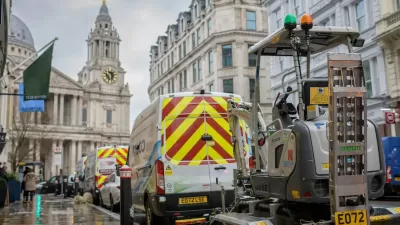This article from Next American City looks at escalators -- the expensive, energy-intensive, and often under-used transportation mode.
"Their primary function is to move significant numbers of people from one floor to another in an environment where conventional staircases cause traffic jams, but most of the time, they are chronically underused."
"According to statistical findings attached to the Energy Efficiency Act, which became law in 2006, 90 billion people each year ascend and descend on escalators, making it a more popular form of transportation than commercial airliners. The national energy use of escalators is estimated at 2.6 billion kilowatt hours per year, equivalent to powering 375,000 houses; its cost is roughly $260 million."
"In order to cut down on wasted energy, Congress has been flirting with converting standard escalators into intermittent escalators, which run only when someone steps onto them. The Energy Efficiency Act calls for the installation of intermittent escalators in the Capitol Building, to set an example for the rest of the nation."
FULL STORY: Taken for a Ride

Americans May Be Stuck — But Why?
Americans are moving a lot less than they once did, and that is a problem. While Yoni Applebaum, in his highly-publicized article Stuck, gets the reasons badly wrong, it's still important to ask: why are we moving so much less than before?

Using Old Oil and Gas Wells for Green Energy Storage
Penn State researchers have found that repurposing abandoned oil and gas wells for geothermal-assisted compressed-air energy storage can boost efficiency, reduce environmental risks, and support clean energy and job transitions.

Placekeeping: Setting a New Precedent for City Planners
How a preservation-based approach to redevelopment and urban design can prevent displacement and honor legacy communities.

Idaho Data: Unexpected Vehicle Repairs Exacerbate Housing Instability, Eviction Risk
Over 21 percent of clients struggle with transportation barriers.

A Year-Long Investigation On Permanent Supportive Housing
The New York Times reveals what’s working and what’s not in the cornerstone of Housing First.

Survey: US Public Spaces Not Meeting Community Needs
A lack of funding prevents many U.S. parks and public spaces from playing a more significant role in helping residents meet daily needs.
Urban Design for Planners 1: Software Tools
This six-course series explores essential urban design concepts using open source software and equips planners with the tools they need to participate fully in the urban design process.
Planning for Universal Design
Learn the tools for implementing Universal Design in planning regulations.
Heyer Gruel & Associates PA
City of Moreno Valley
Institute for Housing and Urban Development Studies (IHS)
City of Grandview
Harvard GSD Executive Education
Salt Lake City
NYU Wagner Graduate School of Public Service
City of Cambridge, Maryland





























